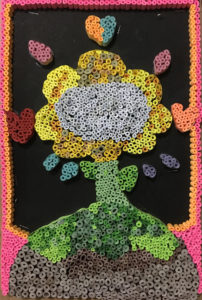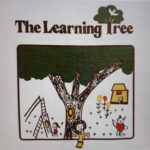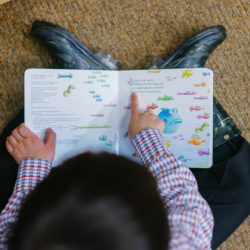Photo from pxhere
I am a mother to a shy child – or shall I say, selectively shy: comfortable with a few people, like family and a few close friends, but not confident talking with people in general. In public situations, my daughter would avoid talking to people if she could. If she had a question, she would rather have someone else ask it for her. She does not like calling attention to herself. She grew up around parents who are not particularly shy (although I am, to a certain extent), especially with a dad who is a public speaker.
When I think about many opportunities she might be missing out on because of her shyness, I feel helpless. How do I draw her out? I sought to ask Teacher Francie Lacanilao-Castañeda, founder and directress of The Learning Tree Child Growth Center.
Upon entering The Learning Tree’s compact campus, the first thing I noticed past the main gate was a white hopscotch outline painted on the green concrete grounds. I could tell immediately that this is a fun place. That is confirmed by the sound of joyful shrieks of kids playing basketball and running around with friends.
As I wait for Teacher Francie, I am ushered to a simple conference room that you can tell has seen its day. After all, it used to house a seminary a few decades ago. But what caught my attention were a few of the children’s art works that adorn the room. You see the children’s creative work adorning the hallways too, as well as the stairway. You can tell that the teachers here celebrate not just their children’s handiwork, but also the careful and creative thinking that went into them.


No wonder the children I’ve encountered so far from TLT seem to exude a quiet confidence. Confident, but not cocky. Able to speak their mind when they have to. Confident, but not entitled. What’s the secret to developing confident children, Teacher Francie? She gave me the following advice for drawing out a shy child (I use the female pronoun as I apply the tips in my mind to my own daughter):
1. Approach her personally and gently whenever you see her by herself. Engage her in conversation. Ask her who her friends are. If she responds, she is warming up to you and will know that you are approachable and that you are her friend. She will then feel safe talking to you.
2. Encourage her to participate in group activities. Be gentle; don’t be too aggressive in your invitation. Ask, “Would you like to try…?” For instance, if Teacher Francie notices a child tapping her foot during circle time (indicating that the child has rhythm), she can approach the child and ask if she would like to try out for their angklung ensemble. If she notices that a child can sing, then she can be invited to perform with a group. Performing on stage will not be as intimidating for a shy child when she is doing so with a group. It will also slowly build up confidence.
3. Be patient. When the child comes and joins your activity, sometimes she might be there, but not yet fully participating. That’s alright. Just observe small cues that she might be warming up.
4. Affirm the child personally and specifically, but do it discreetly. When you do see her warming up, don’t call too much attention to her by saying, “Look at her! She’s very good!” or “Good job!” Instead, approach her personally and be specific in your affirmation about what the child did well. Then you can invite her to try a next-step challenge. “Would you like to try doing this part?”
I was quite surprised with her advice. I thought children who appear shy need a lot of public affirmation. But this might actually be counterproductive. So, do affirm them, but do so specifically and gently, but not too much that it calls the attention of others.
What they need from you, she said, is to be approachable. Let them know that they can talk to you. Teacher Francie’s final reminder: Do not label them as “shy,” or they might embrace the label.
On our way out of the conference room, Teacher Francie took me to the TLT library. The library took on the Learning Tree theme: they had a huge wooden bookshelf in the shape of a tree adorning one wall of the room. You can go upstairs to the mezzanine and read near the “foliage” of the tree, or stay downstairs and read “under” the tree near its “trunk”.


The reading desks nearby also had the tree design on the edges of their frames and desk lamps designed to look like a tree and its branches.
But what impressed me most was one boy of about 7, reading there at that time, along with two other girls in the library. When we came in, he asked Teacher Francie, “Teacher, who is she? Is she a visitor?” She replied, “Yes. Why don’t you introduce yourself and ask her name?” Then he said, “Hello! What is your name?” “Hello! My name is Michelle,” I replied. “Hello, Tita Michelle! My name is DJ, and this is _____ (gesturing to the girl nearest him).” (I later learned that DJ is a Grade 2 student and studies there for free as the child of the school custodian) Teacher Francie then asked him, “What about her? (gesturing to the other girl) What’s her name?” He shook his head with a smile, admitting that he didn’t know the other girl’s name.
So he asked her. Then the children took turns shaking my hand and putting my hand to their forehead (a Filipino sign of respect called pagmamano) – and there it is again, that healthy confidence. They must be doing things right here!
After saying our goodbyes, I left the school enriched – and hopeful that I could draw out and affirm and build up my child’s confidence in the proper way.


Michelle Joaquin is the editor-in-chief of Familywise Asia and is wife to Boris and mom to daughters Ysobel, 18, and Julia, 12.
Related Posts
-
What Can Parents Do When A Child Shows Signs of Depression?
What can parents do when a child shows signs of depression? Are there ways to…
-
Getting Your Child to Read
Reading isn't only an important milestone for your child, it's also an experience you can…
-
Inspiring the Best Out of Your YOUnique Child
The YOUnique Rule is: Treat others the way they want to be treated. That is…




